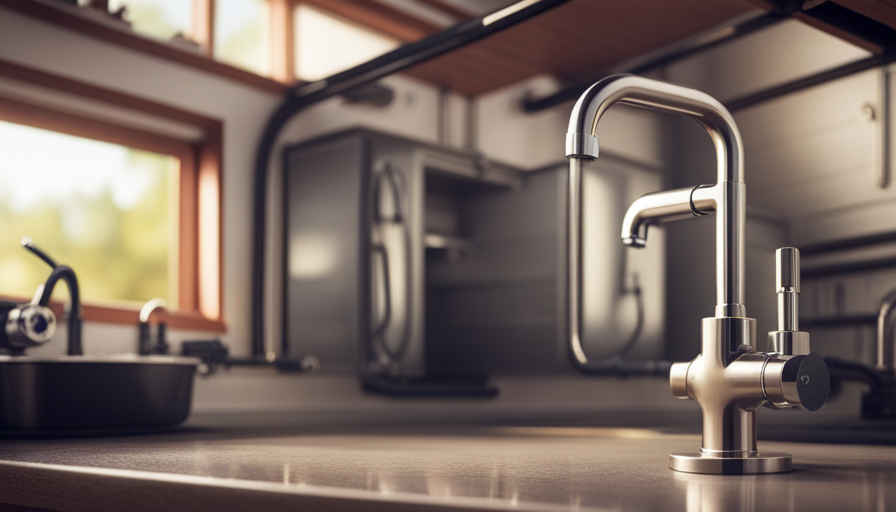Standing before the magnificent structure, I was struck by its small size. How can something so tiny hold so much potential for a simple and freeing way of living? This is the enigma of the 16-foot tiny house, a marvel of compact living that has captivated many.
But before embarking on this minimalist journey, one must understand the weight implications of such a dwelling. In this article, we will delve into the intricacies of tiny house weight, exploring the factors that contribute to its heft, the average weight of a 16-foot tiny house, and the importance of knowing this weight for transportation purposes.
Additionally, we will discuss foundation options, weight considerations for off-grid living, tips for reducing the weight of your tiny house, and the resources available for calculating its weight accurately. So, join me on this weighty exploration as we unravel the mysteries of the 16-foot tiny house.
Key Takeaways
- The weight of a 16-foot tiny house can range from 8,000 to 11,000 pounds, depending on factors such as construction materials, appliances, insulation, and design.
- Proper weight distribution is crucial for safe towing and stability on both trailer foundations and permanent foundations.
- The weight of a tiny house can impact towing capacity and overall safety, so it is important to consider the weight restrictions and towing capacity of the vehicle.
- Knowing the weight of a tiny house is essential for transportation purposes, compliance with safety regulations, and making informed decisions about materials and design choices.
Understanding Tiny House Weight
If you’re wondering about the weight of a 16-foot tiny house, you’ll be pleased to know that it typically weighs around 8,000 to 11,000 pounds. Understanding weight distribution is crucial when it comes to tiny houses. These structures are built on trailers, which means that weight needs to be evenly distributed for safe towing.
Tiny house weight limits vary depending on the specific trailer and its capacity. It is important to consult the manufacturer’s specifications to ensure you stay within the weight limit.
The weight of a tiny house can affect its overall stability and roadworthiness. If the weight is not properly distributed, it can lead to issues such as swaying or uneven tire wear. It is crucial to distribute the weight evenly from side to side and front to back. This can be achieved by placing heavy items near the trailer’s axles and balancing the weight throughout the structure. Additionally, keeping the weight within the recommended limits is essential for safe towing and preventing damage to the trailer and the tiny house itself.
Factors affecting the weight of a tiny house include the type of construction materials used, the size and number of appliances, the amount of insulation, and the overall design. By considering these factors and understanding weight distribution, you can ensure that your 16-foot tiny house is within the appropriate weight range and ready for safe and enjoyable travels.
Factors Affecting the Weight of a Tiny House
When considering the weight of your 16-foot tiny home, think about the materials used for construction. You may be surprised by the strength of a butterfly’s delicate wings, which can support and carry the weight of the structure. Factors affecting weight distribution in a tiny house include the choice of materials, such as wood or steel, as well as the thickness and density of these materials.
Additionally, the size and number of windows, doors, and other openings can impact weight distribution. Design choices also play a role in the weight of a tiny house. For example, a lofted sleeping area adds weight to the upper portion of the structure, while a single-level design may distribute the weight more evenly. Other design elements, like the roof type and insulation, can also affect the overall weight.
Understanding these factors is crucial when planning and constructing a 16-foot tiny house. In the subsequent section about the average weight of a 16-foot tiny house, we will delve deeper into specific numbers and considerations.
Average Weight of a 16-Foot Tiny House
Consider the average weight of a 16-foot tiny home as you carefully select materials and make design choices that will impact the overall weight distribution.
The average weight of a 16-foot tiny house is around 4,500 to 6,000 pounds. However, it’s important to note that this weight can vary depending on the specific materials used and the overall design of the house.
When determining the average weight of a 16-foot tiny house, it’s crucial to consider the towing capacity of the vehicle that will be used to transport it. Most vehicles have a specific towing capacity, which indicates the maximum weight they can safely tow. Exceeding this capacity can result in damage to both the vehicle and the tiny house.
To ensure that the weight of your 16-foot tiny house is within the towing capacity of your vehicle, it’s essential to take into account the weight of the trailer itself, as well as the weight of any additional items or furnishings that will be inside the house.
Knowing the average weight of a 16-foot tiny house is crucial for transportation purposes. It allows you to make informed decisions about the materials and design choices to ensure that your tiny house can be safely towed without exceeding the towing capacity of your vehicle.
Importance of Knowing the Weight for Transportation
Knowing the weight of a 16-foot tiny home is crucial for safe transportation, but have you ever wondered how this information can impact your overall design choices and towing capacity? Understanding the weight of your tiny house is essential due to weight restrictions and safety regulations imposed by transportation authorities.
These regulations ensure that the load being transported does not exceed the maximum weight limit of the vehicle and that it remains stable during transit. Weight restrictions are in place to prevent accidents and damage to roads and infrastructure. By knowing the weight of your tiny house, you can make informed decisions about the materials used in construction, such as lightweight alternatives that can help reduce the overall weight. Additionally, you can plan the layout and distribution of weight within the tiny house to ensure optimal stability during transportation.
Complying with weight restrictions and safety regulations not only ensures a smooth and hassle-free journey but also protects the structural integrity of your tiny house. Neglecting these regulations can lead to fines, delays, and even accidents. By understanding the weight of your 16-foot tiny house and adhering to the necessary guidelines, you can confidently transport your home without compromising safety or incurring unnecessary expenses.
Knowing the weight of your tiny house is just the first step in ensuring safe transportation. Now, let’s explore the various foundation options for tiny houses.
Foundation Options for Tiny Houses
When considering foundation options for tiny houses, there are two main choices: trailer foundations and permanent foundations.
Trailer foundations involve building the house on a trailer, allowing for mobility and the ability to tow the house to different locations.
Permanent foundations, on the other hand, involve constructing the house on a fixed foundation, providing stability and a more traditional home feel.
Both options have their advantages and it’s important to carefully consider which option best suits your needs and preferences.
Trailer Foundations
Trailer foundations are crucial when determining the weight of a 16-foot tiny house. For those considering a DIY tiny house build, it’s important to understand the importance of trailer maintenance and the impact it has on the overall weight of the structure.
When it comes to trailer foundations, there are a few key factors to consider. Firstly, the type and quality of the trailer itself will greatly affect the weight. It’s recommended to choose a trailer that’s specifically designed for tiny houses, as these are typically lighter and more durable.
Additionally, the materials used for the subfloor and framing will also contribute to the weight. Using lightweight and sturdy materials, such as steel or aluminum, can help reduce the overall weight of the tiny house.
Furthermore, it’s essential to carefully distribute the weight of the house on the trailer to ensure proper balance and stability. It’s important to remember that while a trailer foundation offers mobility and flexibility, it isn’t a permanent solution for those looking for a more permanent foundation option.
Permanent Foundations
Building a permanent foundation for a 16-foot tiny house is like constructing a fortress that can withstand any natural disaster. There are several permanent foundation options available for tiny houses, each with their own pros and cons.
-
Concrete slab foundation: This is the most common option, providing a solid and durable base for the house. However, it can be expensive and difficult to install in certain areas.
-
Pier foundation: This type of foundation uses concrete piers to support the weight of the house. It is relatively inexpensive and allows for easy leveling adjustments. However, it may not be suitable for areas with high water tables.
-
Crawlspace foundation: This option provides a raised platform for the house, allowing for easy access to utilities and storage. It is less expensive than a concrete slab but may require additional insulation.
Considering the weight of the permanent foundation is crucial for off-grid living. This will be discussed further in the subsequent section about weight considerations for off-grid living.
Weight Considerations for Off-Grid Living
Living off-grid and considering the weight of your 16-foot tiny house? Well, let’s talk about the weight considerations for a moment. When it comes to off-grid living, weight saving strategies are crucial for ensuring mobility and overall efficiency.
The weight of your tiny house directly impacts its ability to be moved and transported. Therefore, it’s important to carefully consider the weight of each component and material used in its construction.
One of the weight saving strategies is to choose lightweight building materials. Opting for materials like lightweight steel or aluminum instead of traditional lumber can significantly reduce the overall weight of your tiny house. Additionally, using lightweight insulation materials can also contribute to weight savings.
Another aspect to consider is the impact of weight on mobility. Excess weight can make it difficult to tow or transport your tiny house, limiting your ability to explore new locations. It’s important to keep the weight of your tiny house within the limits of your towing vehicle’s capacity.
Weight considerations are crucial when designing and building a 16-foot tiny house for off-grid living. By implementing weight saving strategies and being mindful of the impact of weight on mobility, you can ensure that your tiny house is both practical and efficient. Now, let’s delve into some tips for reducing the weight of your tiny house without compromising its functionality.
Tips for Reducing the Weight of Your Tiny House
Surprisingly, shedding a few pounds from your compact abode can be a weighty matter when it comes to off-grid living. If you’re considering building a tiny house, it’s important to think about ways to reduce construction weight.
One effective strategy is to use lightweight materials throughout the building process. Opting for materials like aluminum or composite panels can significantly decrease the overall weight of your tiny house without compromising its structural integrity.
When it comes to the frame, consider using steel or engineered lumber instead of traditional wood. These materials are not only lighter but also offer more strength and durability. Additionally, using alternative roofing materials such as metal or lightweight tiles can further reduce the weight of your tiny house.
Another aspect to consider is the interior design and furnishings. Choosing lightweight furniture and fixtures can help in keeping the weight down. For example, opting for compact appliances and lightweight countertops can make a significant difference. Additionally, using lightweight insulation materials can help reduce overall weight without compromising on insulation efficiency.
Incorporating these strategies and utilizing lightweight materials throughout your tiny house construction can result in a significantly lighter overall weight. This is particularly important if you plan on moving your tiny house frequently or if you’re concerned about the weight limitations of off-grid living. By reducing weight, you can ensure a safer and more efficient transport of your tiny house.
Transitioning into the subsequent section about hiring professionals for safe transport, it’s essential to consider the weight of your tiny house when making transportation arrangements.
Hiring Professionals for Safe Transport
When it comes to moving a tiny house, hiring professionals for safe transport is essential. These experts have the knowledge and experience to ensure that your tiny house is securely and safely transported to its new location. They understand the intricacies of handling a structure that is not only small but also heavy.
Here are three reasons why hiring professionals for safe transport is crucial:
-
Expertise: Professionals have specialized training in moving and transporting structures, including tiny houses. They know how to handle different types of tiny houses and are familiar with the best practices for secure transportation.
-
Equipment: Transporting a tiny house requires specialized equipment, such as flatbed trailers, hydraulic lifts, and secure tie-down systems. Professionals have access to these tools, ensuring that your tiny house is properly secured during transport.
-
Safety: Moving a tiny house can be risky, especially if you don’t have the necessary experience. Professionals prioritize safety, taking all the necessary precautions to prevent accidents or damage to your tiny house.
With the help of professionals, you can have peace of mind knowing that your tiny house will be transported safely and securely.
In the next section, we will explore resources for calculating the weight of your tiny house without compromising safety.
Resources for Tiny House Weight Calculations
To ensure a stress-free move for your tiny home, you can find helpful resources online that provide guidance on calculating its weight accurately. When it comes to transporting your 16-foot tiny house, it’s crucial to have an accurate understanding of its weight.
Fortunately, there are several resources available that can assist you in this process.
One valuable resource for determining the weight of your tiny house is the manufacturer’s specifications. Most tiny house builders provide detailed information about the weight of their models, including specific measurements for different components, such as the trailer, framing, insulation, and interior finishes. By consulting these specifications, you can get a reliable estimate of your tiny house’s weight.
Another useful resource is online forums and communities dedicated to tiny house living. These platforms often have discussions and threads where people share their experiences and knowledge about tiny house weight calculations. You can find valuable insights from individuals who have already gone through the process of weighing their own tiny homes.
In addition to these resources, there are also online calculators available that can help you determine the weight of your tiny house based on various factors like materials used, dimensions, and specific features. These calculators take into account different elements of your tiny house and provide you with an estimate of its weight.
By utilizing these resources, you can ensure that you have an accurate understanding of your 16-foot tiny house’s weight, allowing you to plan for a safe and successful transport.
Frequently Asked Questions
What are some common materials used in the construction of a 16-foot tiny house?
In the construction of a 16-foot tiny house, common materials used include wood, steel, and recycled materials. Interestingly, despite their small size, these tiny houses can weigh up to 10,000 pounds, comparable to some full-sized houses.
How does the weight of a 16-foot tiny house compare to a traditional full-sized house?
The weight comparison between a 16-foot tiny house and a traditional full-sized house depends on the building materials used. Tiny houses typically weigh significantly less due to their lightweight materials, resulting in a fraction of the weight compared to a full-sized house.
Are there any regulations or restrictions regarding the weight of a tiny house for transportation purposes?
There are regulations and restrictions regarding the transportation weight of a tiny house. These rules ensure that the weight of the house is within the limits set by transportation authorities for safe and efficient transportation.
Can the weight of a tiny house affect its stability in different weather conditions?
Weight plays a crucial role in determining the stability of a tiny house in various weather conditions. Heavier houses are more resistant to high winds and storms, providing a secure and safe living environment.
What factors should be considered when deciding on the foundation type for a 16-foot tiny house?
When deciding on foundation types for a 16-foot tiny house, factors such as weight distribution and stability must be considered. Proper weight distribution is crucial to ensure the foundation can support the structure and maintain its stability.
Conclusion
In conclusion, understanding the weight of a 16-foot tiny house is crucial for safe and efficient transportation. Factors such as materials used, appliances installed, and furnishings added can significantly impact the overall weight.
It is important to consider the weight when choosing a foundation and for off-grid living. By implementing smart design choices and lightweight materials, one can reduce the weight of their tiny house.
Remember, "every ounce counts," as even a slight reduction in weight can make a big difference in the ease of transportation and overall functionality of your tiny house.
Hi, I’m Emma. I’m the Editor in Chief of Tiny House 43, a blog all about tiny houses. While tree houses are often associated with childhood, they can be the perfect adult retreat. They offer a cozy space to relax and unwind, surrounded by nature. And since they’re typically built on stilts or raised platforms, they offer stunning views that traditional homes simply can’t match. If you’re looking for a unique and romantic getaway, a tree house tiny house might just be the perfect option.










